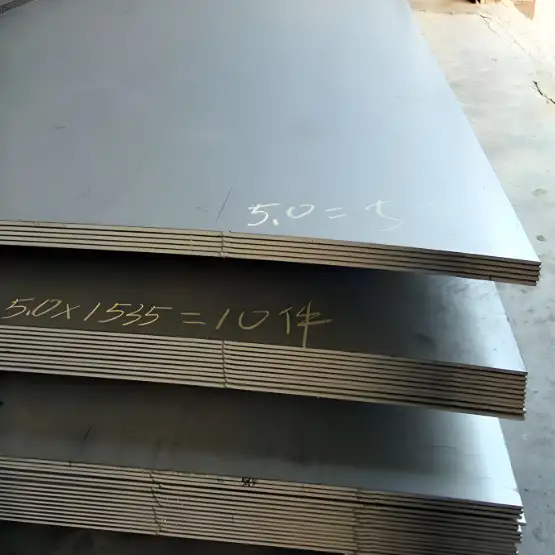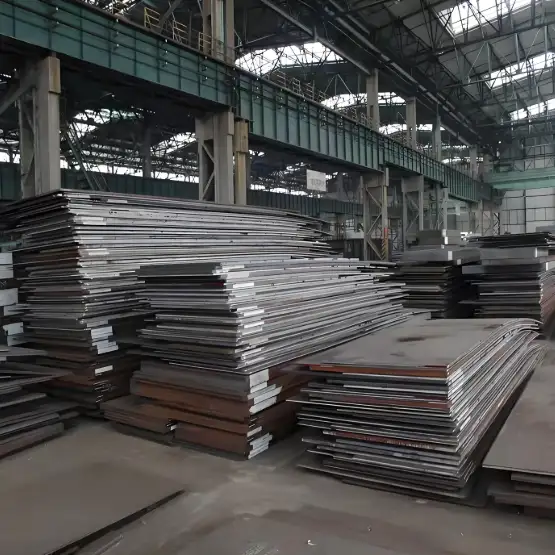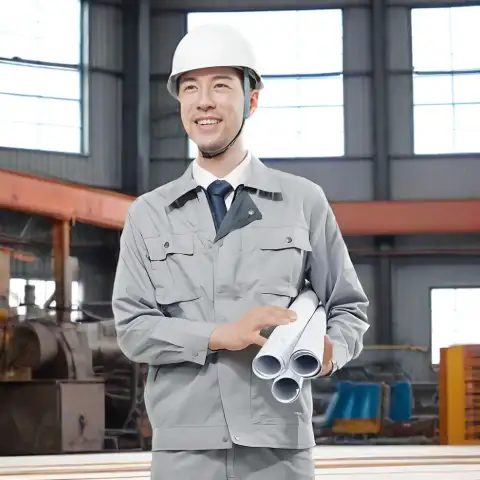AR600 delivers higher surface hardness and superior long-term resistance to sliding and abrasive wear than AR500, making it the better choice for the most severe, high-impact/high-abrasion service (mining buckets, high-velocity chutes, heavy aggregate handling). AR500, however, typically offers a superior balance of formability, weldability and cost-effectiveness for many heavy-duty applications (truck beds, liners, target plates, many pieces of earthmoving equipment). Select AR600 only when the wear environment and total lifecycle cost justify the material’s higher price and tougher fabrication requirements.
What “AR” means
“AR” stands for Abrasion-Resistant. AR steels are specially alloyed and heat treated (commonly quench and temper) to develop high surface hardness while retaining a level of core toughness. The grade number (400, 500, 600, etc.) is an approximate Brinell Hardness Number (BHN) rating; for example AR500 is nominally around 500 BHN and AR600 around 600 BHN. These grades are optimized to resist material loss from sliding, rolling or impact abrasion.
How AR hardening is achieved
AR steels are manufactured by mill heat treatments (austenitize → quench → temper) that create a tempered martensitic microstructure near the surface and through the thickness (“hard through and through” is often a mill claim). The actual hardness depends on chemistry, thickness and the exact thermal cycle. High BHN is obtained by increasing carbon and alloying elements (Cr, Ni, Mo, B) and by controlling quench/temper parameters. Because of these treatments, AR500 and especially AR600 are less ductile and often harder to form than lower AR grades.
Chemical composition: typical ranges
Below are typical compositions reported by mills. Actual chemistry varies by supplier and finished hardness; always request mill test reports (MTRs).
| Element | Typical AR500 (example) | Typical AR600 (example) |
|---|---|---|
| Carbon (C) | ~0.28–0.35% | ~0.40–0.50% |
| Manganese (Mn) | ~0.8–1.6% | ~0.9–1.6% |
| Chromium (Cr) | ~0.8–1.5% | ~1.0–1.5% |
| Nickel (Ni) | ~0.8–1.6% | ~1.5–2.5% |
| Molybdenum (Mo) | 0.2–0.7% | 0.4–0.8% |
| Boron (B) | trace (ppm) | trace (ppm) |
| Typical remarks | balanced for weldability/processability | higher C & alloy to achieve ~600 BHN; lower formability |
(sources: mill datasheets and product pages; example AR500 and AR600 data from industry suppliers.)
Interpretation: AR600 typically contains somewhat higher carbon and alloying additions to reach the increased BHN; this raises wear resistance but reduces ductility and increases the risk of cracking if handled/fabricated improperly.

Mechanical properties & hardness ranges
Typical Brinell hardness ranges you will encounter:
-
AR500: ~470–535 BHN (many producers specify a nominal 500 BHN).
-
AR600: ~570–640 BHN (nominal 600 BHN; some mills report typicals ~620–630 BHN).
| Property | AR500 (typical) | AR600 (typical) | Engineering implication |
|---|---|---|---|
| BHN | 470–535 | 570–640 | AR600 resists abrasive wear more but may be more brittle |
| Yield / Tensile | ~800–1,300 MPa (varies with thickness) | often higher (can exceed 1,600 MPa in some specs) | stronger but less elongation in AR600 |
| Elongation | 8–18% (thin sections higher) | 2–8% (lower, especially in thicker sections) | forming limits and weld crack sensitivity |
| Toughness (Charpy) | variable; often better than AR600 | often lower unless heat-treated specifically for toughness | low temp impact behavior matters for some sites |
(Values depend strongly on supplier, thickness and reported test temperature.)
Practical differences in fabrication
Welding: AR500 is generally easier to weld than AR600, because of lower carbon equivalent in many AR500 formulations. AR600’s higher carbon/alloy content increases the carbon-equivalent number (CEV), raising the risk of hard, brittle weld heat-affected zones (HAZ) and cold cracking unless proper preheat, interpass and post-weld heat treatments are applied. Use low-hydrogen electrodes, control preheat per thickness and follow the mill’s welding guide.
Cutting & Machining: Plasma and oxy-fuel cutting are common for both grades, but AR600 will produce harder kerfs and may blunt cutters faster. Mechanical machining is more challenging on AR600—expect shorter tool life and tighter controls.
Bending & Forming: AR500 can be formed within limits (especially thinner plates) with careful tooling; AR600 is notably less formable and may crack during bending unless specifically produced for improved toughness. If forming is required, work with the mill to obtain a temper that balances toughness and hardness.

Applications: where each grade shines
AR500 common uses
-
Ballistic steel targets and reactive steel targets (AR500 has been widely used for shooting targets because of good combination of hardness and toughness).
-
Truck beds, dump bodies, liners, chutes for medium abrasion.
-
Excavator bucket faces and wear plates for construction equipment where some forming/welding is needed.
AR600 common uses
-
Extremely high abrasion applications: mining buckets with severe sliding abrasion, high-velocity aggregate chutes, crusher liners, long-life hammer and impeller components.
-
Specialty ballistic/armor plates where maximum hardness is required and where weight reduction (thinner plate for same protection) is desired and fabrication challenges can be managed.
Ballistic notes: AR600 can provide better resistance to high-velocity rifle rounds at thinner gauge than AR500, but AR600 plates can be more brittle and may fragment or spall with some impacts unless ballistic backing or anti-spall measures are used. If you design for body/vehicle armor, consult certified armor manufacturers and ballistic test standards—do not assume a given AR grade meets NIJ or military ballistic levels without testing.
Cost, availability and total cost of ownership
-
Up-front cost: AR600 typically costs significantly more per kg/m² than AR500 because of higher alloy content and more exacting heat treatment. Pricing also depends on thickness, plate size and supplier inventories.
-
Lifecycle cost: In extremely abrasive services, AR600’s longer in-service life may offset the higher initial cost by reducing replacement frequency and downtime. For moderate abrasion, AR500 often yields the best lifecycle economics because of lower purchase price and easier installation. AZoM and mill blogs show that AR500 is often the “sweet spot” for many earthmoving and processing applications.
How to evaluate: calculate installed cost per square meter times expected service life (or measure tonnes processed per unit wear). If AR600 doubles service life versus AR500 in your environment, the higher material cost may be justified.
Inspection, testing and standards
Hardness verification: Mills provide Brinell hardness tests and MTRs; always specify plate BHN tolerance and require hardness testing on delivery. For critical projects, require Charpy impact tests at the operating temperature.
Standards & tolerances: AR plates are often supplied to mill technical datasheets rather than a single international standard; however, dimension tolerances and flatness often reference EN 10029 / ASTM A6 practices, and many manufacturers (e.g., SSAB Hardox) publish detailed datasheets and welding guides. Ask for manufacturer welding and bending guidance specific to the grade and thickness you purchase.
Safety, spalling and ballistic considerations
When AR steel is struck by high-energy projectiles it can produce spall (high-velocity fragments) that are hazardous. For shooting ranges or armor, use spall liners, angle plates to deflect fragments, and follow ballistic safety protocols. AR600’s higher hardness can reduce penetration but may increase fragmentation risk unless properly backed or engineered for ballistic service.
Selection checklist
Use this quick table to choose between AR500 and AR600:
| Criterion | Prefer AR500 | Prefer AR600 |
|---|---|---|
| Moderate sliding abrasion | ✔ | |
| Severe/high velocity abrasion | ✔ | |
| Need for bending/forming on site | ✔ | |
| Easier welding & field repair | ✔ | |
| Maximum possible service life for liners | ✔ | |
| Budget constrained up-front | ✔ | |
| Ballistic protection with minimal thickness (and controlled fabrication) | ✔ |
Case example (mining bucket)
-
Scenario: bucket liner in abrasive ore handling.
-
AR500 result: lasts X months (depends on ore), easier replacement, lower downtime cost.
-
AR600 result: lasts significantly longer (often 2–3× in extreme sliding wear), but initial downtime for replacement less frequent and fabrication requires controlled welding. Choose AR600 if top-line throughput cost of downtime exceeds additional material and fabrication cost.
Practical procurement tips
-
Ask for Mill Test Reports (MTRs) with BHN, chemical analysis, tensile and Charpy where required.
-
Specify hardness by BHN and the through-thickness requirement (surface only vs through-hardened).
-
Request the mill’s welding/bending guide and adhere to preheat/post-weld procedures.
-
If ballistic use is intended, require ballistic certification—don’t rely on BHN alone.
FAQs
-
Q: Is AR600 always better than AR500?
A: No! AR600 has higher hardness and wear resistance but reduced formability and more difficult welding; AR500 is usually the pragmatic choice for many heavy-duty applications. -
Q: How do mills guarantee hardness?
A: By quench & temper processing and by supplying BHN tests on representative samples in the MTR. Specify BHN tolerance in the purchase order. -
Q: Can I weld AR600 in the field?
A: Yes! but control preheat/interpass temperature, use low-hydrogen consumables, and follow the mill’s welding procedure; sometimes PWHT is recommended. Consult the mill. -
Q: Will AR500 stop rifle rounds?
A: AR500 is used in some ballistic plates and targets; however, ballistic performance depends on thickness, plating configuration, and ammunition. For certified protective equipment, rely on tested and certified armor systems. -
Q: Does AR600 rust faster than AR500?
A: Corrosion rate depends on environment and surface treatment (paint, coatings). Chemistries are similar; neither is stainless—apply protective coatings where corrosion is a concern. -
Q: What about hardness testing method — Brinell vs HBW?
A: Brinell Hardness is commonly used (HBW or BHN). Mills usually state “500 HBW” etc. Ensure the test method is named in the MTR. -
Q: Can AR600 be cold bent?
A: Cold bending is risky and often not possible without cracking. If bending is required, consult with the supplier for bendability guarantees or order pre-bent pieces from the mill. -
Q: Which grade has better impact toughness at low temperature?
A: Generally AR500 (or specially produced AR grades with toughness guarantees) will outperform AR600 unless the AR600 is tailored for impact toughness—request Charpy test data at your operating temperature. -
Q: Are there international equivalents to AR500/AR600?
A: Some branded wear steels (e.g., SSAB Hardox series) correspond in hardness (Hardox 500 ≈ AR500). Local mill trade names differ; always compare BHN and MTRs rather than name. -
Q: How should I specify AR plate in my procurement docs?
A: Include grade name (AR500/AR600), required BHN range, thickness, required MTR tests (BHN, chemical, tensile, Charpy where relevant), dimensional tolerances, welding/bending instructions and packaging/flatness expectations.
Final recommendation
-
For general heavy-duty construction and mid-severe abrasion, choose AR500 for its balance of wear life, cost and fabrication friendliness.
-
For extreme sliding or high-velocity abrasive wear, or where weight reduction (thinner plate) is critical and fabrication control is available, AR600 is appropriate despite higher cost and tougher fabrication demands.
AR500 VS AR600 technical comparison
| Feature | AR500 | AR600 |
|---|---|---|
| Nominal BHN | ~500 (470–535) | ~600 (570–640) |
| Primary advantage | Better ductility / weldability; lower cost | Maximum wear resistance; longer service in extreme abrasion |
| Typical uses | Targets, truck bodies, medium wear liners | Mining buckets, crusher parts, severe chutes |
| Fabrication difficulty | Moderate | High |
| Ballistic performance | Good in thicker plates | Better at thinner gauges (with caveats) |
| Common supplier docs | AR500 datasheets / MTRs | AR600 datasheets / MTRs |
(Always confirm with vendor MTRs prior to acceptance.)

